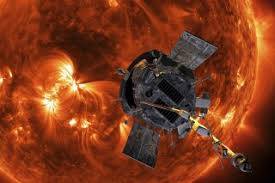**Parker Solar Probe Has Touched the Outer Reaches of a Star**
In an unprecedented milestone in space exploration, NASA's Parker Solar Probe has become the first spacecraft to "touch" the Sun, entering the outermost layer of the star's atmosphere, known as the corona. This groundbreaking achievement is a testament to human ingenuity and marks a new era in our understanding of the Sun and its profound influence on the solar system.
### **What Is the Parker Solar Probe?**
Launched in August 2018, the Parker Solar Probe is a NASA mission designed to study the Sun up close, coming closer than any spacecraft has ever dared. The probe was named after astrophysicist Eugene Parker, who first theorized the existence of the solar wind—streams of charged particles released from the Sun.
Equipped with state-of-the-art instruments and a revolutionary heat shield, the Parker Solar Probe is capable of withstanding temperatures of up to 2,500 degrees Fahrenheit (1,377 degrees Celsius). It uses its heat shield, made of carbon-composite material, to protect its sensitive instruments while venturing through one of the most extreme environments in the universe.
### **Touching the Sun: A Historic Feat**
On its mission to unravel the mysteries of our closest star, the Parker Solar Probe has now ventured into the Sun’s corona, a region where temperatures soar into the millions of degrees and magnetic fields dominate. This historic achievement occurred during its eighth close approach, or perihelion, in April 2021. However, it took months for scientists to confirm the milestone due to the sheer volume of data collected.
The Sun's corona, often visible during solar eclipses as a glowing halo, is a turbulent region where the solar wind originates. By entering this region, the Parker Solar Probe has crossed what scientists call the Alfvén critical surface—the boundary where the Sun’s gravitational and magnetic forces no longer hold the solar wind back.
For the first time in history, a human-made object has entered this chaotic zone, providing direct measurements and observations that were previously impossible.
### **What the Parker Solar Probe Found**
The spacecraft’s journey into the corona has yielded groundbreaking data. For the first time, scientists have been able to directly measure magnetic fields, plasma waves, and particles within the Sun’s atmosphere. These findings are helping to answer longstanding questions about the Sun's behavior and its impact on the solar system.
One key discovery involves the Alfvén critical surface itself. The Parker Solar Probe found that this boundary is not smooth but wrinkled and dynamic, influenced by the Sun’s magnetic activity. This insight is critical for understanding how solar wind—streams of charged particles that can affect Earth’s magnetic field and technological systems—is generated and accelerated.
The spacecraft also detected switchbacks, sudden reversals in the Sun’s magnetic field that were first observed in earlier missions. These switchbacks appear to play a significant role in energizing and transporting solar wind, offering new clues about the fundamental mechanisms driving the Sun’s activity.
### **Why Does This Matter?**
Studying the Sun’s corona and solar wind is not just about scientific curiosity—it has real-world implications. Solar wind and solar storms, caused by bursts of energy from the Sun, can disrupt satellites, power grids, and communication systems on Earth. By understanding the origins and dynamics of these phenomena, scientists hope to develop better predictive models and mitigate their impact.
The Parker Solar Probe’s mission also sheds light on fundamental astrophysical processes that occur in other stars and across the universe. The knowledge gained from this mission will help us better understand stellar evolution and the conditions that sustain life in planetary systems.
### **Technological Marvels of the Mission**
The success of the Parker Solar Probe is a testament to cutting-edge engineering and technological innovation. The spacecraft’s heat shield, known as the Thermal Protection System (TPS), is a marvel of modern materials science. At just 4.5 inches thick, the TPS enables the probe to withstand intense heat and radiation while maintaining its instruments at a safe operating temperature.
Additionally, the spacecraft employs an autonomous navigation system that allows it to adjust its position and shield itself from the Sun's most intense rays, ensuring that its instruments remain functional throughout its mission.
### **What’s Next for the Parker Solar Probe?**
The Parker Solar Probe’s mission is far from over. The spacecraft will continue its journey, completing a total of 24 orbits around the Sun by 2025. Each orbit brings it closer to the star, with future passes expected to take it within 3.83 million miles of the Sun’s surface—a distance closer than any spacecraft has ever approached.
As the probe continues to gather data, scientists anticipate even more groundbreaking discoveries about the Sun’s magnetic fields, plasma waves, and energy transfer processes.
### **The Significance of This Milestone**
The Parker Solar Probe’s achievement of "touching" the Sun is a monumental step in humanity’s quest to understand the universe. By venturing into the corona, the spacecraft has opened a new window into the physics of our closest star, laying the groundwork for future explorations of other stars and cosmic phenomena.
This milestone also serves as an inspiration, highlighting the power of human curiosity and innovation. The Parker Solar Probe reminds us that even the most daunting challenges—like reaching the outer atmosphere of a star—can be overcome with ingenuity and determination.
### **Conclusion**
The Parker Solar Probe’s journey into the Sun’s corona is a defining moment in space exploration and solar physics. By venturing closer to the Sun than ever before, it has begun to unravel the mysteries of our star, offering insights that could transform our understanding of the solar system and beyond.
As we continue to explore the cosmos, the Parker Solar Probe stands as a shining example of humanity’s relentless drive to push the boundaries of what is possible.


